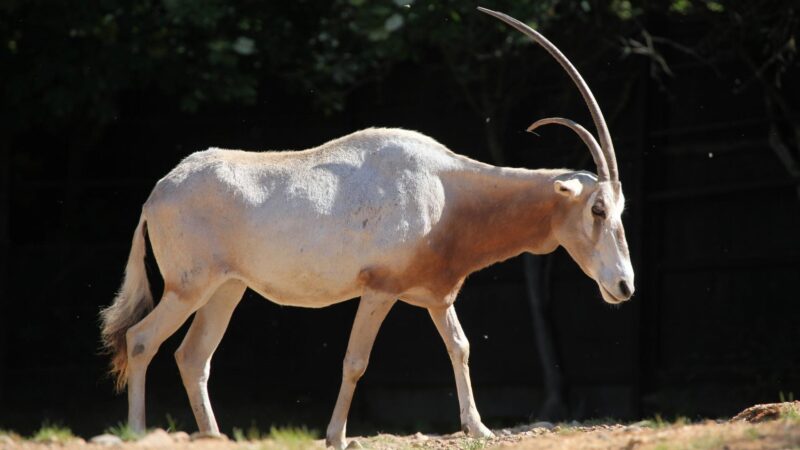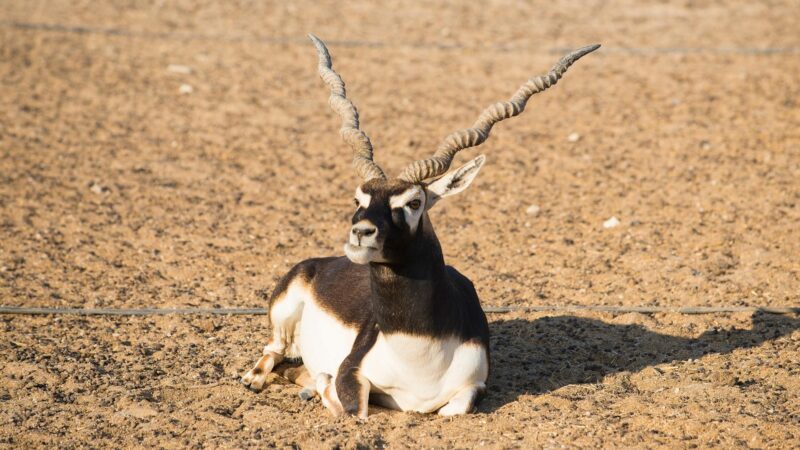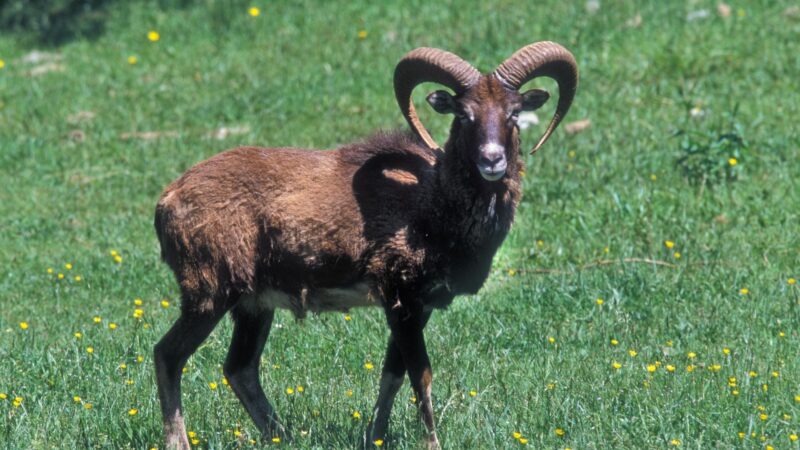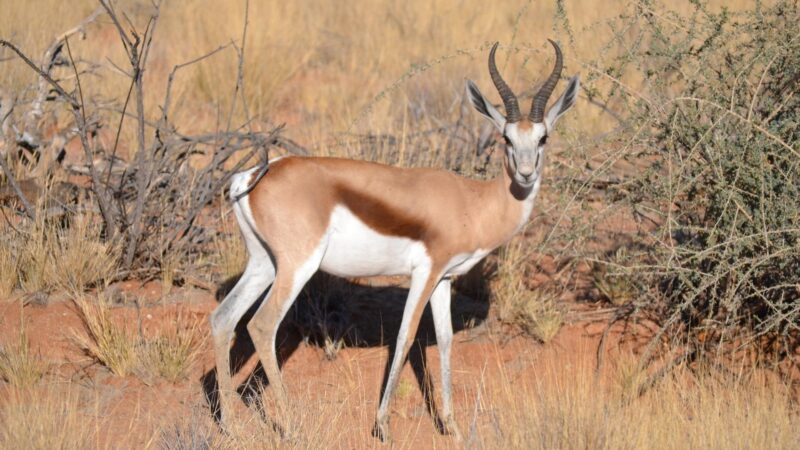Horns are useful to many animals. There are varieties of uses, such as for defense against predators. Moreover, they use their horns for dominance in pursuit of mating and protecting their territories. Aside from different uses, horns can be in different forms, and some of them are curly.
The animals with curly horns are Kudu, Bighorn sheep, Scimitar oryx, Blackbuck, Addax or Screwhorn antelope, Markhor, Mouflon, Hebridean sheep, Alpine ibex or Capra ibex, Impala, Sable antelope, and Giant eland.
Is there something special about these animals with curly horns? You’ll know the answer and other details by reading this article.
Table of Contents
Animals With Curly Horns
Kudu

Kudus is one of the tallest antelopes in the world. Also, this species has the largest horns among the bush-buck tribe. It has a curly or twisted horn that can be made into a musical instrument.
- Scientific Name: Tragelaphus strepsiceros
- Appearance: There are 6 to 10 stripes on a kudu’s body. A beard is seen on a male but not on a female. Also, the male’s color gets darker as it ages. Kudus of any gender have tails with a black tip, and they have a white underside.
- Color: Reddish-brown to blue-gray
- Lifespan: 7 to 8 years or up to 23 years
- Habitat: Deciduous woodlands, areas with thicket and bush cover and rich vegetation
- Height: 100 to 150 cm
- Weight: 120 to 315 kg
- Horn Length: Around 120 cm
- Diet: Leaves, grass, herbs, vines, flowers, fruits
- Place of Origin: Ethiopian
- Characteristics: Social; solitary; motile; not aggressive
Bighorn Sheep

Both male and female bighorn sheep have horns but the latter’s smaller and only slightly curved. These horns unceasingly grow in terms of length and circumference. No shedding happens annually. In summer, these sheep have a dark and glossy coat, but it fades when winter comes.
- Scientific Name: Ovis canadensis
- Appearance: You can distinguish a bighorn sheep from other related species by its notably large, curved horns. There’s white outlining and a white rump patch behind its four legs.
- Color: Light brown, deep dark brown, light brown
- Lifespan: 6 to 15 years or up to 19 years
- Habitat: Alpine meadows, foothill country near the rugged, rocky cliffs, grassy mountain slopes
- Height: 160 to 180 cm
- Weight: 53 to 127 kg
- Horn Length: Up to 109.2 cm
- Diet: Leaves
- Place of Origin: Nearctic region
- Characteristics: Migratory; motile; dominance hierarchies; diurnal; social and gregarious
Scimitar Oryx

This nomadic oryx uses its long, ridged horns in what seems like a fencing match when competing for necessary resources. During a duel for the sake of mating, the inferior male will lower his head as a sign of defeat to the dominant male.
- Scientific Name: Oryx dammah
- Appearance: The long, ridged horns of this oryx curved backward. They have a sharp tip. The black and white face mask is something unique about these creatures.
- Color: Rusty brown, white
- Lifespan: Up to 27 years
- Habitat: Semi-desert environments, barren steppes of deserts
- Height: Up to 1.7 m
- Weight: Around 200 kg
- Horn Length: 1 to 1.2 m or longer
- Diet: Herbs, grasses, buds, juicy roots, fruits, vegetables
- Place of Origin: Ethiopian
- Characteristics: Dominance hierarchies; social; motile
Blackbuck (Indian Antelope)

The horns that are ringed at the base with four spiraling turns are only seen on males. Blackbucks are usually silent, but they make a hissing sound when danger is around.
- Scientific Name: Antilope cervicapra
- Appearance: Males and females differ in color as the former has a rich dark brown coating while the latter is yellow. Nonetheless, they both have white underparts and white circles around their eyes. Blackbucks are graceful with their slender build.
- Color: Rich dark brown, yellowish, white
- Lifespan: 15 to 18 years
- Habitat: Open woodlands, semi-desert areas, deciduous forests, near grasslands
- Height: Up to 120 cm
- Weight: 32 to 43 kg
- Horn Length: 50 to 61 cm
- Diet: Grasses
- Place of Origin: Palearctic and Oriental regions (India and Pakistan)
- Characteristics: Dominance hierarchies; motile; social and gregarious; diurnal in a cool season; silent, shy, and wary; known for great speed and endurance
Addax/Screwhorn Antelope

Unfortunately, this is a slow-running species that is overtaken by its faster predators. Both males and females have horns that have 1.5 to 3 spirals.
- Scientific Name: Addax nasomaculatus
- Appearance: This antelope is white in summer, and it turns grayish-brown in winter. There’s a black tuft of hair on its forehead, as well as white markings on any part of its body. It has widely splayed hooves for treading on the sand.
- Color: White, grayish-brown
- Lifespan: 19 to 25 years
- Habitat: Desert, dune, grassland, savanna, surrounding a stony country
- Height: 150 to 170 cm
- Weight: 60 to 125 kg
- Horn Length: Around 72 cm
- Diet: Leaves, flowers, stems, bark, wood
- Place of Origin: Ethiopian
- Characteristics: Territorial; social; dominance hierarchies; diurnal; motile
Markhor

While the female markhor is social, the male is solitary. Both have corkscrew-like horns, which are their unique features. They’re the body parts that can make you distinguish this animal even from afar.
- Scientific Name: Capra falconeri
- Appearance: This species is highly gendered dimorphic mainly in size. It has corkscrew-like horns that are bold and flared. Furthermore, these horns have outward twirls.
- Color: Light tan, dark brown, black
- Lifespan: 10 to 13 years
- Habitat: Mountainous area, scrub forests
- Height: 140 to 180 cm
- Weight: 32 to 50 kg (female); 80 to 110 kg (male)
- Horn Length: Up to 24 cm (female); Up to 160 cm (male)
- Diet: Shrubs, leaves, twigs, bark, stems
- Place of Origin: Palearctic region
- Characteristics: Migratory; motile; diurnal; territorial; solitary; dominance hierarchies; social
Mouflon

This creature is deemed as the ancestors of the modern sheep. It has a pair of beautiful, striking, balanced, and curly horns. Due to its wild, dramatic looks, you can easily tell it apart from a bighorn sheep. Although their fur appears short, there are two coats, and the exterior layer sheds water.
- Scientific Name: Ovis orientalis orientalis
- Appearance: Not only the horns are balanced, but the head of this sheep per the size of its body. It has a Roman nose too, that is slightly arched on the side view of its face.
- Color: Red-brown
- Lifespan: 8 to 12 years or up to 22 years
- Habitat: Mountains, islands
- Height: 25 to 35 inches
- Weight: 70 to 120 pounds
- Horn Length: 20 to 33 inches
- Diet: Grasses, shrubs, trees, fruits
- Place of Origin: Mediterranean islands, Iran, Iraq, and the Caucasus
- Characteristics: Shy; gregarious; non-territorial
Hebridean Sheep

This is a multi-horned species, as some Hebridean sheep have four horns. Surprisingly, they prefer rough vegetation. They have hard hooves, so they’re not prone to foot problems.
- Scientific Name: Ovis aries
- Appearance: This is a small sheep that is black all over. But its coat becomes brown under the sun, and it turns gray as it gets older. It’s a multi-horned sheep as some have more than 2 horns.
- Color: Black, brown
- Lifespan: Up to 15 years
- Habitat: Grassland, heathland
- Height: Unknown
- Weight: 40 to 60 kg
- Diet: Grass, weeds
- Place of Origin: Scotland
- Characteristics: Moves quickly; docile and friendly; can team up with sheepdog
Alpine Ibex/Capra Ibex
During the breeding season, the males use their long horns that curve backward in a fighting competition to mate with a female. The victor will have the right to breed with a group of 10 to 20 females.
- Scientific Name: Capra ibex
- Appearance: The head of this animal is short and broad. It has a thick beard and dull coat that molts twice a year.
- Color: Brown, gray
- Lifespan: 10 to 18 years or up to 22 years
- Habitat: Mountains up to 3,200 m elevation, brushy areas, rolling slopes
- Height: 1.3 to 1.6 m
- Weight: 65 to 100 kg
- Horn Length: 70 to 140 cm
- Diet: Leaves, stem, wood, bark
- Place of Origin: Ethiopian, Palearctic region
- Characteristics: Solitary; social; nomadic; dominance hierarchies; motile; crepuscular
Impala

The way the impala runs is closely related to its S-shaped horns because it follows a zigzag pattern. It’s diurnal, and it spends the night ruminating. Male impalas can use their horns to defend their territories, including their females.
- Scientific Name: Aepyceros melampus
- Appearance: Only the male impalas have S-shaped horns. Both genders have red-brown hair and sides that have a paler color. Black stripes can be seen on their foreheads, tails, ear tips, and thighs.
- Color: Red-brown
- Lifespan: 13 to 17 years
- Habitat: Grassland, woodland
- Height: 75 to 95 cm
- Weight: 45 to 60 kg
- Horn Length: 45 to 91.7 cm
- Diet: Leaves, stems, bark, wood
- Place of Origin: Ethiopian
- Characteristics: Social; dominance hierarchies; motile; diurnal; territorial
Sable Antelope

Sable antelopes can be both diurnal and nocturnal as some of them are out feeding even until dark. They’re territorial, but dominant males allow subordinates to graze on their territories given that they won’t be after the females. Fights can be inevitable, but it rarely leads to death.
- Scientific Name: Hippotragus niger mbarapi
- Appearance: This is a good-looking antelope with its robust build and thick neck. Further enhancements are made by its long, majestic horns that curved backward and its thick mane behind its head. The horns of male cable antelopes are curvier than the females. Males are typically black, and females are brown-black.
- Color: Black, brown-black
- Lifespan: 17 to 19 years
- Habitat: Grasslands, savanna woodlands
- Height: 117 to 140 cm
- Weight: 220 to 238 kg
- Horn Length: 81 to 165 cm (males); 61 to 102 cm (females)
- Diet: Foliage, herbs, grasses
- Place of Origin: Ethiopian
- Characteristics: Dominance hierarchies; social; nomadic; territorial; motile; nocturnal
Giant Eland

Male giant Eland can be solitary, but it uses its horn to assert its position in the hierarchy. This usually takes place during mating season.
- Scientific Name: Taurotragos derbianus
- Appearance: The body and horn sizes of males are much larger than the females. But both of their horns are massive and spiraled. They have 6 to 12 white, vertical stripes on their sides.
- Color: Sandy gray
- Lifespan: Up to 20 years
- Habitat: Savannas, grasslands, mountainous areas
- Height: 220 to 290 cm
- Weight: 400 to 1000 kg (males); 300 to 600 kg (females)
- Horn Length: Up to 66 cm (females); up to 123 cm (males)
- Diet: Leaves, trees, herbs, grasses, fruits
- Place of Origin: Ethiopian
- Characteristics: Social; solitary; dominance hierarchies; motile
Asian Water Buffalo

The horns of Asian water buffalos are the most widespread among the bovid family. The base of these horns seems to meet at the forehead. You won’t see their natural body color as they like being covered by mud.
- Scientific Name: Bubalus bubalis
- Appearance: An Asian water buffalo has a long, narrow face, with small ears and huge horns. Sparse hair covers its body, but it may lose most of it when it’s fully grown.
- Color: Black, ashy gray
- Lifespan: 25 to 29 years or up to 34 years
- Habitat: Wet grasslands, tropical and subtropical forests, marshes, swamps
- Height: 1.5 to 1.9 m
- Weight: 800 to 1,000 kg (wild); 250 to 550 kg (domesticated)
- Horn Length: Up to 120 cm
- Diet: Aquatic plants, herbs, crops, leaves, and various vegetation along the stream or river
- Place of Origin: Australian, Oriental, Neotropical, and Palearctic regions
- Characteristics: Nocturnal; diurnal; social; sedentary; motile; dominance hierarchies
Springbok

This is an attractive antelope as it looks like a gazelle. It’s also known for its vertical leaps that can reach 3.5 m when it’s excited or scared.
- Scientific Name: Antidorcas marsupialis
- Appearance: A springbok has a white face, but some lines go between the mouth and eyes. It carries curved horns that form a lyre shape. There’s a distinct skin fold on its mid bunk and rump. When this animal is excited, the fold opens up to show a crest of white mane.
- Color: Reddish brown
- Lifespan: 19 to 20 years
- Habitat: Treeless savanna, farms
- Height: 71 to 86 cm
- Weight: 33 to 46 kg
- Horn Length: 36 to 48 cm
- Diet: Grasses, flowers
- Place of Origin: Ethiopian
- Characteristics: Social; migratory; dominance hierarchies; motile
Curly horns, just like other horns, are used for defense and in fights for territory and mating. Apart from these purposes, these horns make these animals look striking. They make them unique, and you can’t help but just be in awe of their appearance. The length of these horns is also outstanding.
List of Sources
Newell, T. (1999). Tragelaphus strepsiceros. Animal Diversity Web.
Benzon, T. Bighorn Sheep. South Dakota Department of Game, Fish & Parks.
Johnson, H. (2001). Oryx dammah. Animal Diversity Web.
Nocon, W. (1999). Antilope cervicapra. Animal Diversity Web.
Altan, B. (2000). Addax nasomaculatus. Animal Diversity Web.
